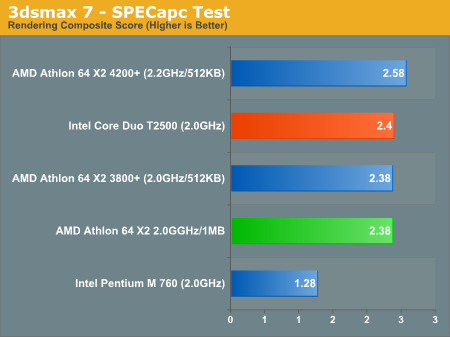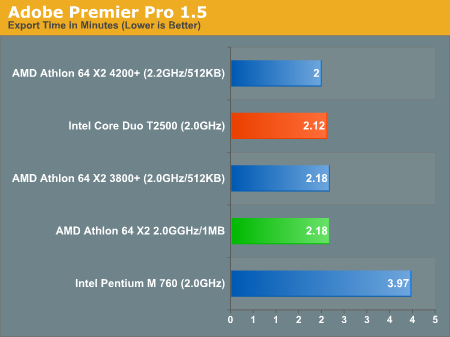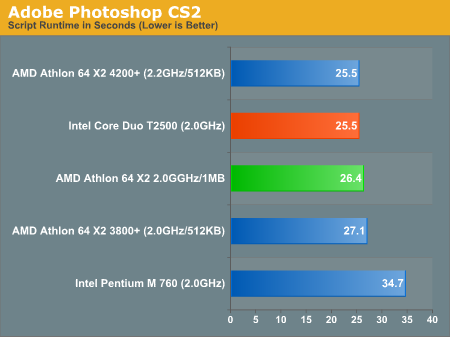Intel Core Duo (Yonah) Performance Preview - Part II
by Anand Lal Shimpi on December 19, 2005 12:55 PM EST- Posted in
- CPUs
Professional Application Performance with 3dsmax, Adobe Premier and Photoshop
We start off our page on professional application performance with an updated version of the SPECapc 3dsmax test, updated for version 7 of the application. The scenes being rendered haven't actually changed, but the reference numbers used to compute the composite scores have, so these scores aren't directly comparable to results from earlier SPECapc tests.
Compared to the Athlon 64 X2, the Core Duo comes out on top, but by a very small margin - once again we're faced with a virtual tie.
The breakdown of the rendering composite score can be found below; the scores in the table are render time in seconds, lower numbers are better:
Moving onto Adobe Premier Pro 1.5, this test is actually one that is used by Intel to showcase the performance of the Pentium 4 processor. With the Pentium 4 absent from this comparison, we were curious as to how it compared to the Core Duo and the Pentium M.
As with virtually any media encoding performance, dual-core processors do extremely well, and this case is no different with the Core Duo T2500 seriously outpacing the Pentium M 760.
The Core Duo T2500 is also able to complete the export process in about 97% of the time of the Athlon 64 X2, which once again ends up being borderline negligible for this test, but it is important to note that this advantage comes without the aid of an on-die memory controller.
Our final test is the only other Intel-supplied test in the suite. This one used to showcase the Pentium 4's performance under Adobe Photoshop CS2 by measuring the time that it takes to run a few filters and resize/export images. The script itself is fairly realistic; however, with Photoshop filters, it is easy to favor one architecture over another, so by no means are these numbers intended to be conclusive of Photoshop CS2 performance.
We start off our page on professional application performance with an updated version of the SPECapc 3dsmax test, updated for version 7 of the application. The scenes being rendered haven't actually changed, but the reference numbers used to compute the composite scores have, so these scores aren't directly comparable to results from earlier SPECapc tests.

Compared to the Athlon 64 X2, the Core Duo comes out on top, but by a very small margin - once again we're faced with a virtual tie.
The breakdown of the rendering composite score can be found below; the scores in the table are render time in seconds, lower numbers are better:
| SPECapc 3dsmax 7 Breakdown | AMD Athlon 64 X2 4200+ | AMD Athlon 64 X2 3800+ | AMD Athlon 64 X2 2.0GHz/1MB | Intel Core Duo T2500 | Intel Pentium M 760 |
| 3dsmax 5 rays | 15.406 | 15.829 | 16.109 | 14.297 | 25.246 |
| CBALLS2 | 20.125 | 22.281 | 22.094 | 21.187 | 42.201 |
| SinglePipe2 | 92.844 | 101.906 | 101.922 | 107.359 | 203.492 |
| UnderWater | 142.938 | 157.219 | 156.203 | 169.188 | 316.055 |
Moving onto Adobe Premier Pro 1.5, this test is actually one that is used by Intel to showcase the performance of the Pentium 4 processor. With the Pentium 4 absent from this comparison, we were curious as to how it compared to the Core Duo and the Pentium M.

As with virtually any media encoding performance, dual-core processors do extremely well, and this case is no different with the Core Duo T2500 seriously outpacing the Pentium M 760.
The Core Duo T2500 is also able to complete the export process in about 97% of the time of the Athlon 64 X2, which once again ends up being borderline negligible for this test, but it is important to note that this advantage comes without the aid of an on-die memory controller.
Our final test is the only other Intel-supplied test in the suite. This one used to showcase the Pentium 4's performance under Adobe Photoshop CS2 by measuring the time that it takes to run a few filters and resize/export images. The script itself is fairly realistic; however, with Photoshop filters, it is easy to favor one architecture over another, so by no means are these numbers intended to be conclusive of Photoshop CS2 performance.

Overall System Performance using WorldBench 5
Media Encoding Performance with DVD Shrink, WME, Quicktime and iTunes










103 Comments
View All Comments
mitcoes - Saturday, April 22, 2006 - link
The msot important question about corel duo, is if dual processors Apple Machines with ATI X1900XT woul be a better machine than AMD and Pentium with one processor at same clocks. Better when core duo would arrive to 3 Mhz or nearby. Becouse hard gamers, and renderers would buy this (expending a few more bucks) and have the choice of use MAC OS, Win XP, an Linux on the same machine with opengl games probably going better in Leopard than in XP becouse of the better networking of UNIX and Linux over TCP/IP. The test of packets losed with Quake3 XP vs Leopard would be a great test, becouse probably AMD, and Pentium with same clocks and ATI would have similar preformance in games that are not prepared for two processors, but Photoshop CS2, blender And other CAD/CAM apps would run better. Perhaps The future new market of Apple machines are hard gamers, and hard users like architects, renderers, animators and so one. But it must be tested. And I want to know if MAC mainboards are better than ASUS and Gigabyte ones (or other better if them exists).Cygni - Wednesday, December 21, 2005 - link
Congrat AT commenters! I have to say, this is the new HIGH SCORE for useless, incorrect, biased, self important posts in the history of AT!Really, i was going to respond to each one in turn, but I think its far easier just to make this one post where i point out that many, many, many of you should likely try lurking a bit instead of instantly hitting the reply button and spouting off about latencys, bus widths, and other thing your Toms Hardware Education degree has certified you an expert at. We will all be more intelligent if you didnt post.
IntelUser2000 - Tuesday, December 20, 2005 - link
They should have used low latency DDR2-533 rather than the normal JEDEC specified 4-4-4-12 latency for their reviews. It might be faster then :)).Also, testing Sonoma notebooks have shown that it likes single channel DDR2-533 better than DDR2-400, like how it doesn't benefit from dual channel. I would also like to see DDR2-667 results(over dual channel DDR2-533), as few % here and there will really show Yonah's potential.
coldpower27 - Tuesday, December 20, 2005 - link
Yes that would be interesting, as Anantech does have Corsair DDR2-667 3-2-2-8 available in their repitoire.StuckMojo - Tuesday, December 20, 2005 - link
I'd like to see compilation benchmarks. Lots of us use our laptops for software development.
Betwon - Tuesday, December 20, 2005 - link
Compilation?At the recent Spec CPU Cint2000 test--The most fast x86 CPU about compiler is P4 670.
176.gcc 2195/2195 ponits
PM@2.26GHz(1995/1994) is fast than FX-55@2.6GHz(1931/1933).
IntelUser2000 - Tuesday, December 20, 2005 - link
If any of you actually care to search for transistor performance of Intel's and AMD/IBM, you can see that AMD/IBM's the newest 65nm process is only 2-3% faster but Intel is providing the numbers at HALF the leakage.There WILL be X2 clock speed like versions of Yonah with higher TDP and being graded as EE.
-Equal platform comparisons are never possible.
-DDR2's power advantage isn't as great as you think.
-We don't know if Turion would benefit at all from DDR2 in performance, the claimed 15% or so is at best case, aka single benchmark. It always happens, companies say some wonder number and in reality its even worse than the previous one.
Betwon - Tuesday, December 20, 2005 - link
The very low latency of L2 cache is the main real reason? AT may be foreget that L2 can be shared, which is different with AMD.Schmide - Tuesday, December 20, 2005 - link
Correct me if I'm wrong. Doesn't the AMD architecture have a 3 cycle L1 latency due to an exclusive L1 L2 cache relationship. While Intel uses a 2 cycle L1 inclusive L1 L2 cache relationship. With the larger cache sizes now, the more costly exclusive set seems to be holding AMD back. However, this higher latency could be the reason AMD is able to reach higher speeds using a lower process.As for the power consumption, I wonder if the board design had anything to do with the X2 being 30% higher. Chime in here
On die memory controller advantage AMD.
DDR2 lower power consumption advantage Intel
65nm process advantage Intel
Mature SOI advantage AMD.
Betwon - Tuesday, December 20, 2005 - link
You are wrong about the cache of Yonah. The mobile CPU is different with the Netburst.Yonah's L1 latency is 3 cycles, and it is a kind of write-back cache, which needs not always copy the data to L2. L2 latency is 14 cycles(AT said), which is the same with AthonX2. And Yonah's number of pipeline stages is 11,12, or 13. The AthonX2 is 12-stage. So, (Include AT)we believe that Yonah can reach the high frequency. The real reason of Yonah only max 2.16GHz -- for the moblie applications ... to control the power sum.